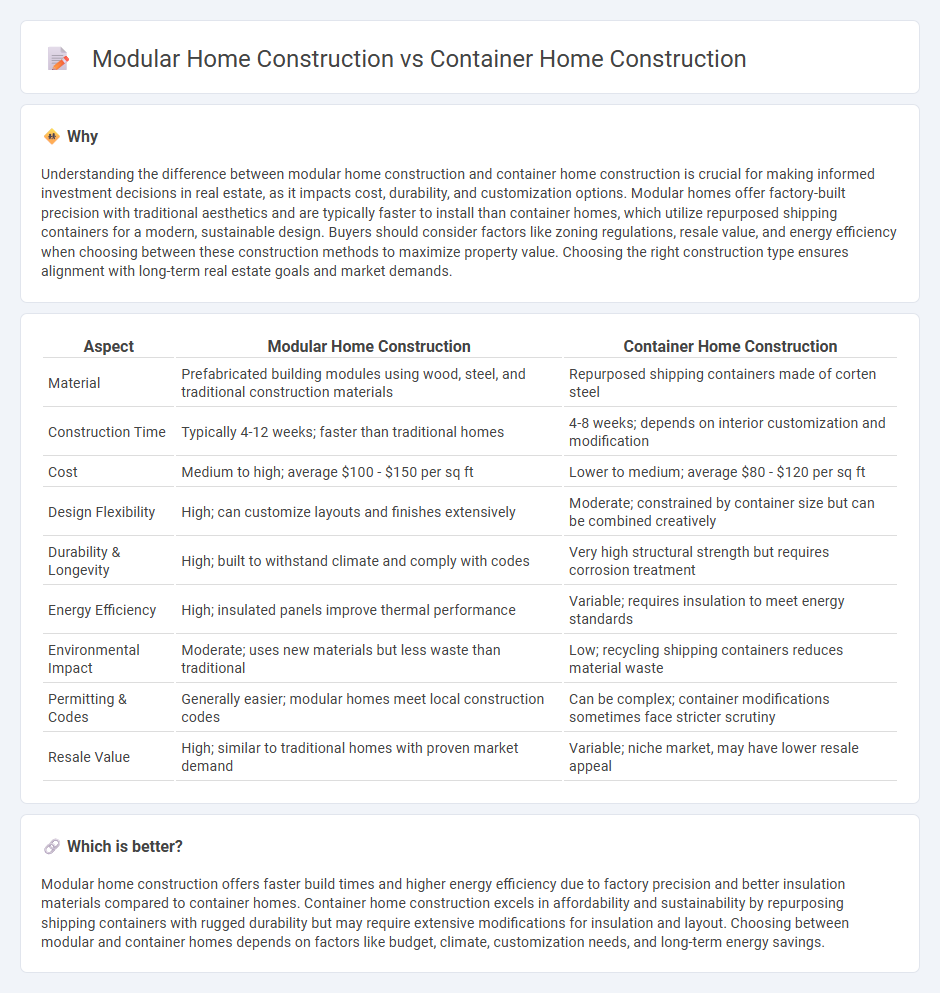
Modular home construction offers precision engineering and rapid assembly using factory-built sections, ensuring high energy efficiency and design flexibility. Container home construction utilizes repurposed shipping containers, providing durability, cost-effectiveness, and eco-friendly benefits through recycling materials. Discover detailed comparisons to determine the best option for your sustainable housing needs.
Why it is important
Understanding the difference between modular home construction and container home construction is crucial for making informed investment decisions in real estate, as it impacts cost, durability, and customization options. Modular homes offer factory-built precision with traditional aesthetics and are typically faster to install than container homes, which utilize repurposed shipping containers for a modern, sustainable design. Buyers should consider factors like zoning regulations, resale value, and energy efficiency when choosing between these construction methods to maximize property value. Choosing the right construction type ensures alignment with long-term real estate goals and market demands.
Comparison Table
| Aspect | Modular Home Construction | Container Home Construction |
|---|---|---|
| Material | Prefabricated building modules using wood, steel, and traditional construction materials | Repurposed shipping containers made of corten steel |
| Construction Time | Typically 4-12 weeks; faster than traditional homes | 4-8 weeks; depends on interior customization and modification |
| Cost | Medium to high; average $100 - $150 per sq ft | Lower to medium; average $80 - $120 per sq ft |
| Design Flexibility | High; can customize layouts and finishes extensively | Moderate; constrained by container size but can be combined creatively |
| Durability & Longevity | High; built to withstand climate and comply with codes | Very high structural strength but requires corrosion treatment |
| Energy Efficiency | High; insulated panels improve thermal performance | Variable; requires insulation to meet energy standards |
| Environmental Impact | Moderate; uses new materials but less waste than traditional | Low; recycling shipping containers reduces material waste |
| Permitting & Codes | Generally easier; modular homes meet local construction codes | Can be complex; container modifications sometimes face stricter scrutiny |
| Resale Value | High; similar to traditional homes with proven market demand | Variable; niche market, may have lower resale appeal |
Which is better?
Modular home construction offers faster build times and higher energy efficiency due to factory precision and better insulation materials compared to container homes. Container home construction excels in affordability and sustainability by repurposing shipping containers with rugged durability but may require extensive modifications for insulation and layout. Choosing between modular and container homes depends on factors like budget, climate, customization needs, and long-term energy savings.
Connection
Modular home construction and container home construction both emphasize prefabrication techniques that enable faster build times and reduced costs compared to traditional construction. Both methods rely on factory-built sections or shipping containers that are transported to the site for assembly, offering enhanced quality control and sustainability benefits. These innovative approaches contribute to affordable housing solutions while minimizing environmental impact through efficient use of materials and waste reduction.
Key Terms
Structural Integrity
Container home construction utilizes repurposed shipping containers made of Corten steel, offering exceptional structural integrity with inherent strength and durability against extreme weather and seismic activity. Modular home construction relies on factory-built sections assembled on-site, optimized for precision engineering and quality control, but structural robustness varies based on materials and design standards applied during manufacturing. Explore detailed comparisons and expert insights to determine which construction method best suits your structural requirements.
Building Codes
Container home construction often faces challenges with building codes due to unconventional materials and structural requirements, necessitating thorough inspections and potential modifications to meet local standards. Modular home construction typically complies more easily with building codes, as modules are built in factory settings following standardized regulations, ensuring consistent quality and faster approvals. Explore in-depth comparisons to understand how building codes impact your construction choices.
Foundation Types
Container home construction primarily utilizes concrete slab or pier foundations to support the steel structure and ensure stability, while modular home construction often employs traditional crawl space, basement, or slab foundations tailored to the modular units. The choice of foundation in container homes is driven by the weight distribution and portability of shipping containers, whereas modular homes require foundations that accommodate their sectional assembly and utility connections. Explore detailed foundation options to determine the best fit for your unique construction project.
Source and External Links
How to Build a Shipping Container Home: A Complete Guide - This guide provides a step-by-step process for building shipping container homes, including preparing the land and choosing a foundation.
Shipping Container Homes - Pros, Cons & Costs - This article discusses the pros and cons of shipping container homes, including their prefabrication, transport ease, and environmental appeal.
Building a 2-Floor Shipping Container Home with a Terrace - This video demonstrates the construction of a two-story shipping container home, highlighting key steps like welding and reinforcing the structure.
 dowidth.com
dowidth.com